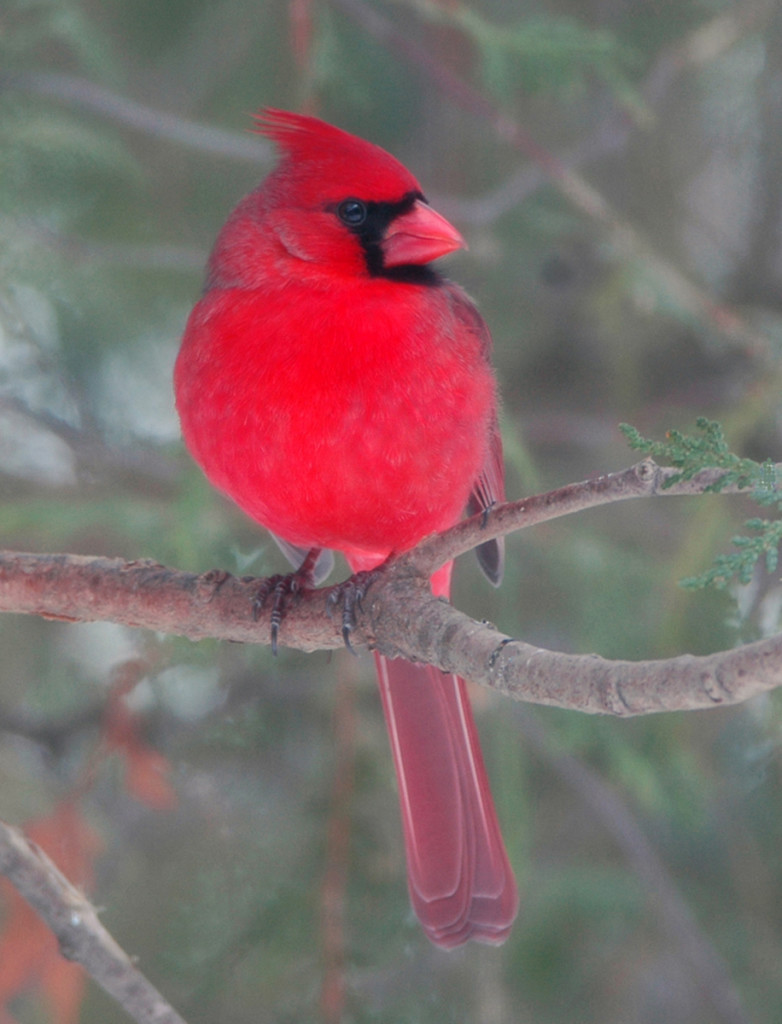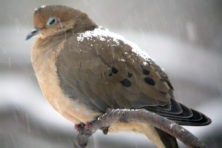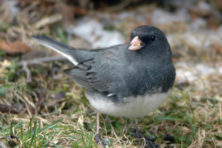Door to Nature: The Christmas Bird
- Share
- Tweet
- Pin
- Share

If the label “Christmas Bird” were to be given to any one species in a predominantly evergreen-tree back yard, it would be the Cardinal. Just one male in his fiery brilliance seems to make the scene come alive. And the more subdued female, wearing her usual patch of orange-red “lipstick,” also stands out beautifully against the deep-green spruces and pines.
John Audubon summed it up perfectly when he said, “In richness of plumage, elegance of motion, and strength of song, this species surpasses all its kindred in the United States.”
How well I recall my first sighting of a male Cardinal during my Army days at Fort Sill, Oklahoma, in the early spring of 1954. We had arrived early at a rendezvous point on the vast firing range, and found ourselves with an hour of free time as we waited for the crew towing the huge artillery cannons to catch up with us. “Hurry up and wait,” was our motto!
The morning was warm and pleasant and the quiet woods inviting, so I grabbed a pair of binoculars from the supply box and set out to explore the nearby territory. These moments of quiet were so precious to me then, for soon the absolute loudest of all artillery pieces, the 216mm (bore size) cannons would be blasting away while we trained diligently to kill people. Unknown to nearly all in our crew, the time would arrive in the future when our hearing would be severely damaged.

An adult male Cardinal sports the most scarlet red of any of our permanent resident birds. Photo by Roy Lukes.
A shrill human-like whistle, “cheer, cheer, cheer,” startled me, and immediately the challenge was on. That musical beacon was so perfect that one could hardly ignore it. The song was one I had never heard before, adding greatly to the excitement. Suddenly there he was, in all his scarlet finery and not in the least concerned with my presence; my very first Cardinal!
It was not until the late 1950s that I saw a Cardinal in my hometown of Kewaunee. About that time I discovered a small printed notice tucked into an old bird book I had purchased at Paul’s Used Book Store in Madison, the city in which I was teaching at the time. The notice was produced in about 1903 and was sent to various birdwatchers throughout Wisconsin asking them to assist in a winter bird survey. Special mention was directed to those living in the southern counties, to be especially on the watch for “cardinal grosbeaks” (as they were referred to then), for a few had been seen near Lake Geneva.
Apparently their range was just beginning to move into Wisconsin. According to old records, Cardinals were only casually seen north of the Ohio River Valley by 1886. Today they are common nesters throughout most of Wisconsin and into southern Ontario.
Surely a combination of factors has brought about their range expansion. The dominant breeding birds in spring drive other Cardinals to different areas. Then, too, Cardinals are known to group together and do some wandering in winter.
Shrikes, hawks, feral cats and too much human activity are known to drive these shy birds to different, more protected environments. Chances are they are encouraged to remain in certain places by the proper protective landscapes and the food set out for them by avid birdwatchers. Come spring some of these birds will nest nearby and continue to bring their young to also feed on the handouts.
Those of you who live near the edges of woods or thickets where tangles of small trees, shrubs and vines grow will very likely see Cardinals. Put sunflower seeds out and the “redbirds” will surely find them. These regular customers will undoubtedly become one of your favorites.
When Charlotte and I lived at the Ridges Sanctuary, where superb Cardinal habitat grew practically up to our back door, we soon came to enjoy the dawn and dusk periods of Cardinal activity. We labeled those hours “Cardinal time.” Often we would sit quietly at the kitchen table within several feet of where the Cardinals came to feed. Charlotte would count the males while I counted the females. Our high count one evening in November of 1975 was 12 males and 8 females, all there at the same time!
Generally by late fall the young will have molted, and by winter, in their first winter plumage, will look just like the adults. The soft olive-gray feather edges will wear off by spring and the males will be adorned in their most aristocratic elegance, the reddest of cardinal reds.
One of their classy characteristics that we are especially fond of is their tail-bobbing and flitting, with a slight side-to-side twisting motion, as they fly away. Their distinctive “chip-chip-chip” call notes, somewhat metallic in quality, are easy for most people to hear. Although both sexes are known to sing, indistinguishably from one another according to some experts, I like to think of the brilliant male, perched high in a Maple tree in early spring, sounding off with his crystal clear “CHEEer, CHEEer, CHEEer” song or his “WHITyear, WHITyear, WHITyear” call.
Cardinals and spring songs? Here Christmas hasn’t even arrived and spring is already on my mind! Oh well, enjoy the winter holidays with all your Cardinals!
If anybody wants to participate in the Christmas bird counts for Sturgeon Bay on Saturday, Dec. 19, or Brussels on Sunday, Dec. 20, please call Wendy Lukes at 920.746.7616. People can count at their feeders if they live within the 15-mile diameter circles, or they can work in the field with numerous field parties. Field area assignments will be made once you offer to help.


